8 Nose Imperfections People Correct with Rhinoplasty
No one’s face is perfect, but some people may have noses that can be a significant source of self-consciousness and low self-esteem. Nose surgery, also called rhinoplasty, can be performed on the nose to correct nasal imperfections and asymmetry.
Nose imperfections are common, which is why rhinoplasty procedures are one of the most popular cosmetic surgeries in the world. Take a look at these eight nose imperfections that can be corrected with rhinoplasty:
Dorsal Hump
A dorsal hump is a cartilage or bone irregularity on the nose that causes a hump in the outline instead of a seamless slope from the bridge to the tip. They do not cause health problems but can lead to dissatisfaction with one’s appearance. The dorsum bone and cartilage connect the nose to the face and is often called the bridge. Rhinoplasty can remove the hump to produce a more aesthetically-pleasing facial profile.
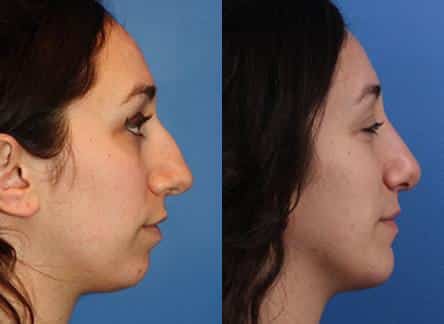
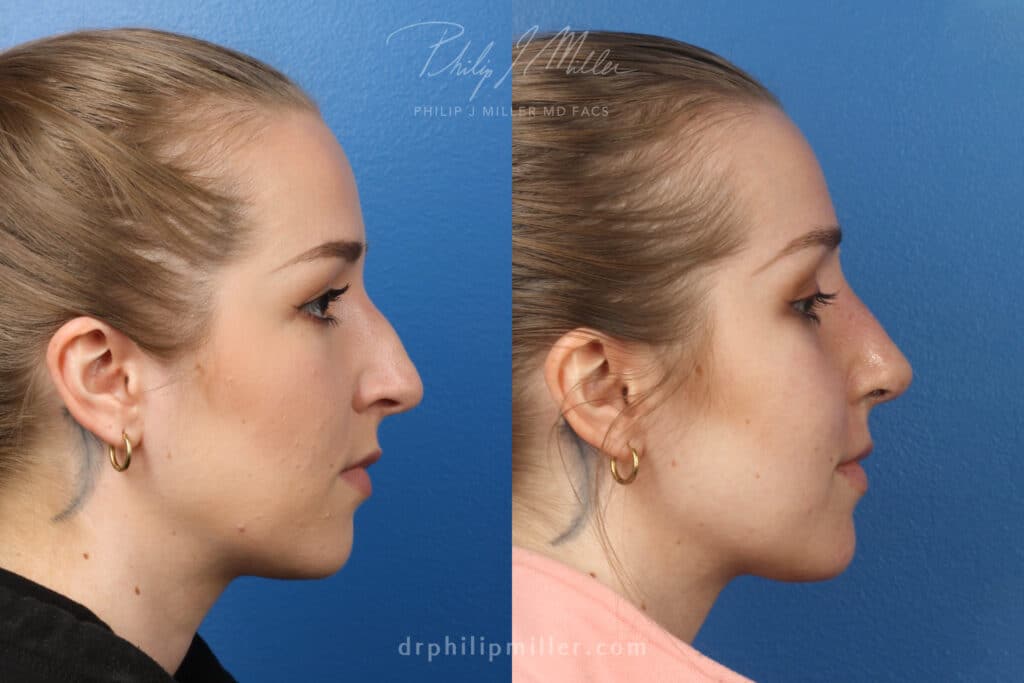
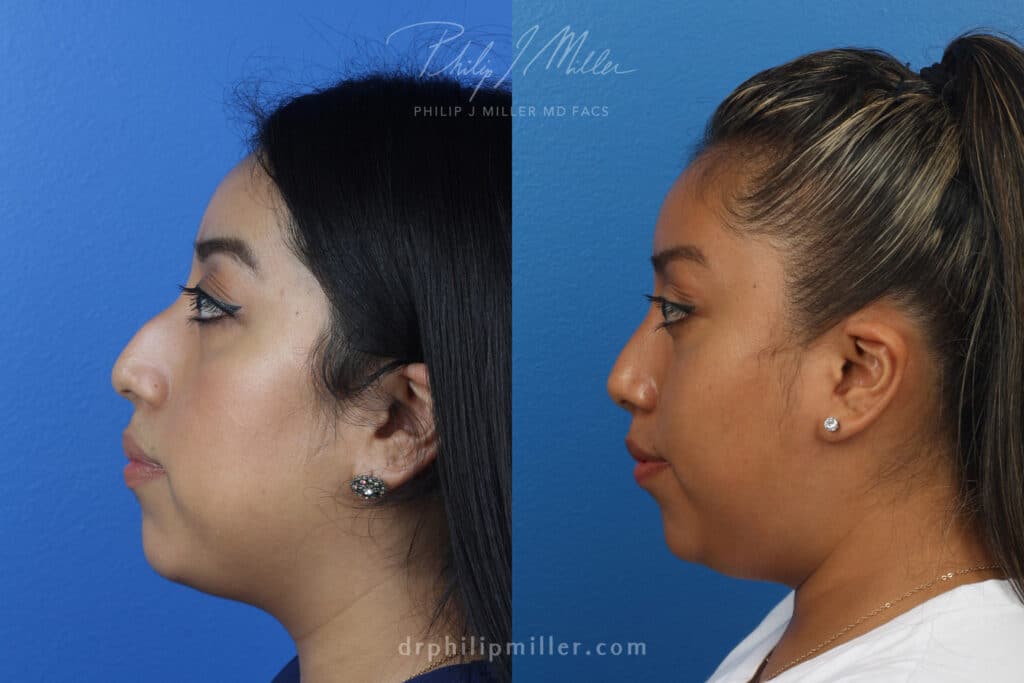
Philip J. Miller, MD, FACS, can also use his microrhinoplasty technique to correct unsightly humps without fracturing bones or using other more invasive approaches. It is an innovative procedure that utilizes an air-powered microrasp with local anesthesia. Using a small incision in the nostril, the specialized device removed the obtrusive layer with extreme precision for a contoured look. Patients experience minimal side effects like swelling and bruising and can return to normal activities within several days.
Wide Nose Bridge
The bridge of the nose extends from the top of the nose, below the eyes, to the tip of the nose and is used to help direct airflow to the nasal passages. In addition to its functional role, the nasal bridge is also considered an important feature of the face that can add to a person’s overall facial appearance and balance.
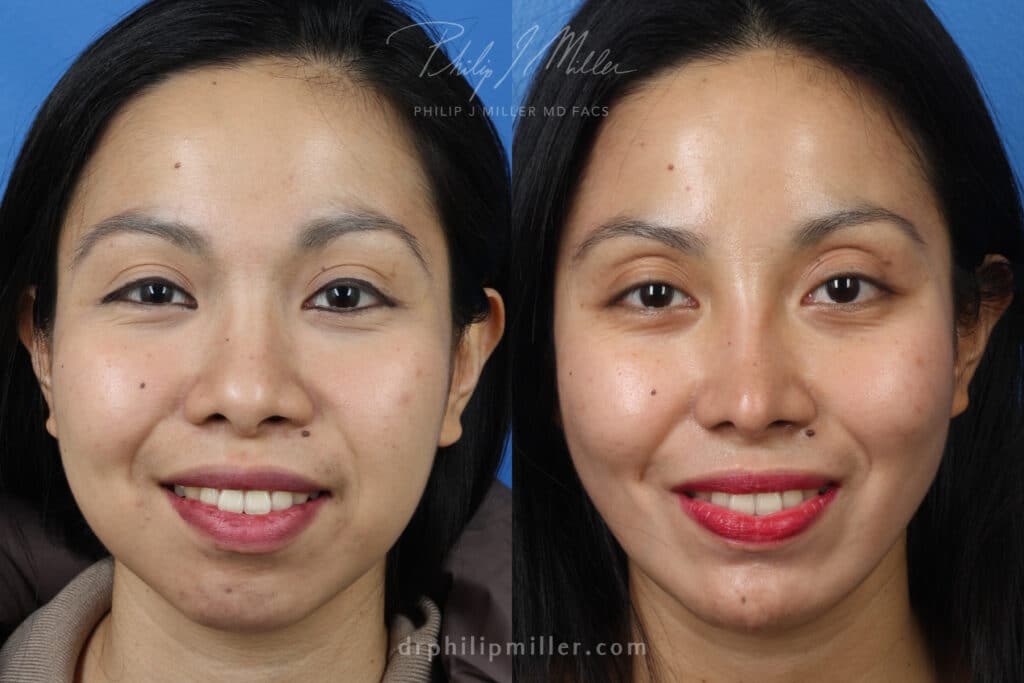
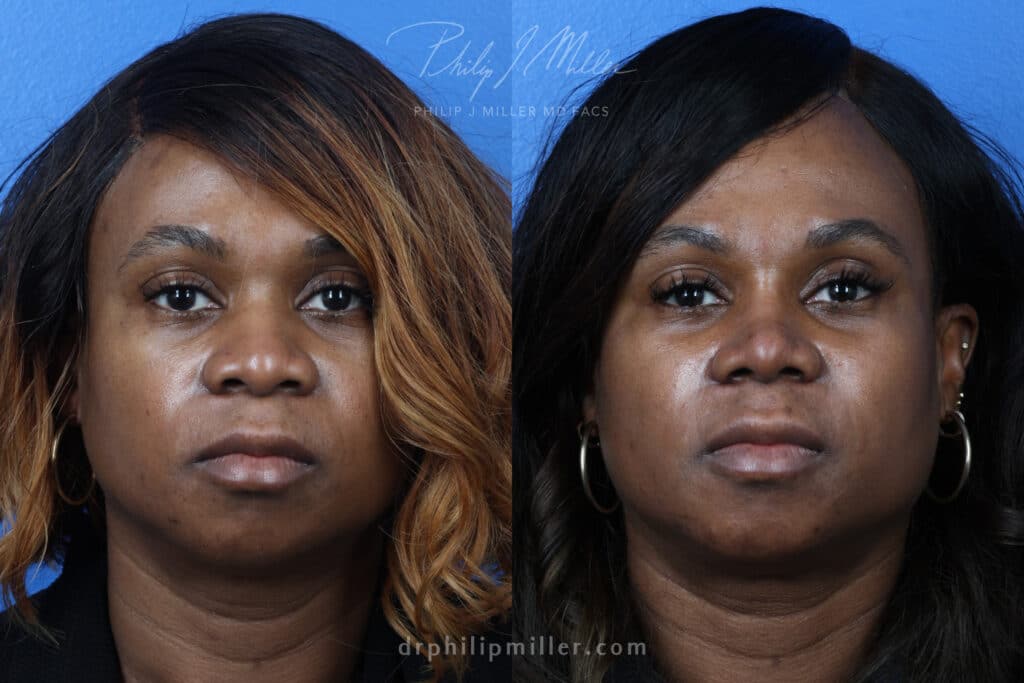
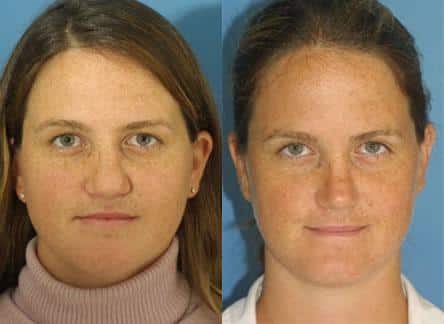
A wide nasal bridge is often common among many Asian, African, and Hispanic ethnicities. It is important to work with a board-certified facial plastic surgeon with experience in ethnic rhinoplasty procedures to ensure beautiful natural results that do not compromise your heritage in these situations. A wide nose bridge can be corrected with a specific technique during a rhinoplasty called an osteotomy, which narrows down a wide nasal bone for a more proportionate look.
Low Nasal Bridge
A low nasal bridge occurs when the bridge is flat and doesn’t protrude. It is a common characteristic among many ethnicities, such as Asian and African patients. A low nasal bridge doesn’t typically cause breathing problems but can be a cosmetic concern. The nasal bridge can be reshaped with a rhinoplasty to create a straighter profile and a more harmonious face shape.
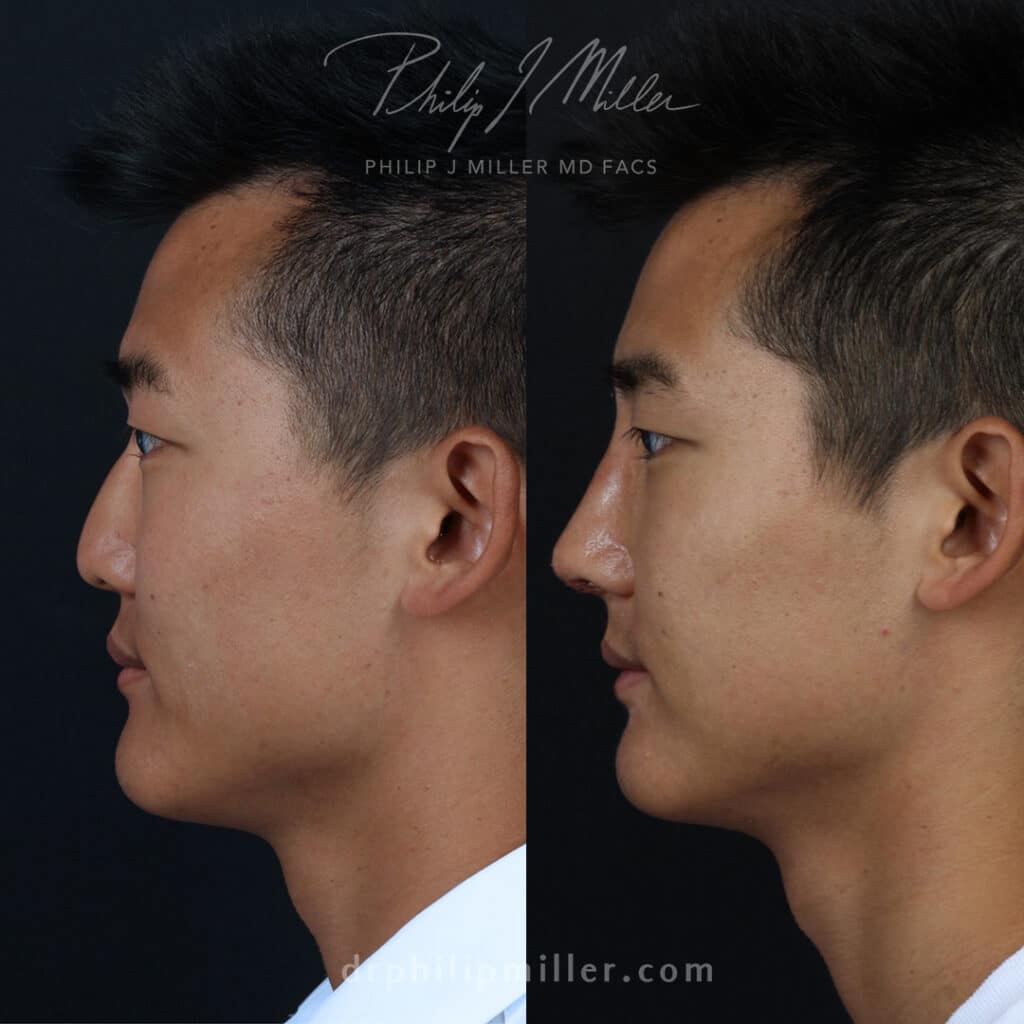
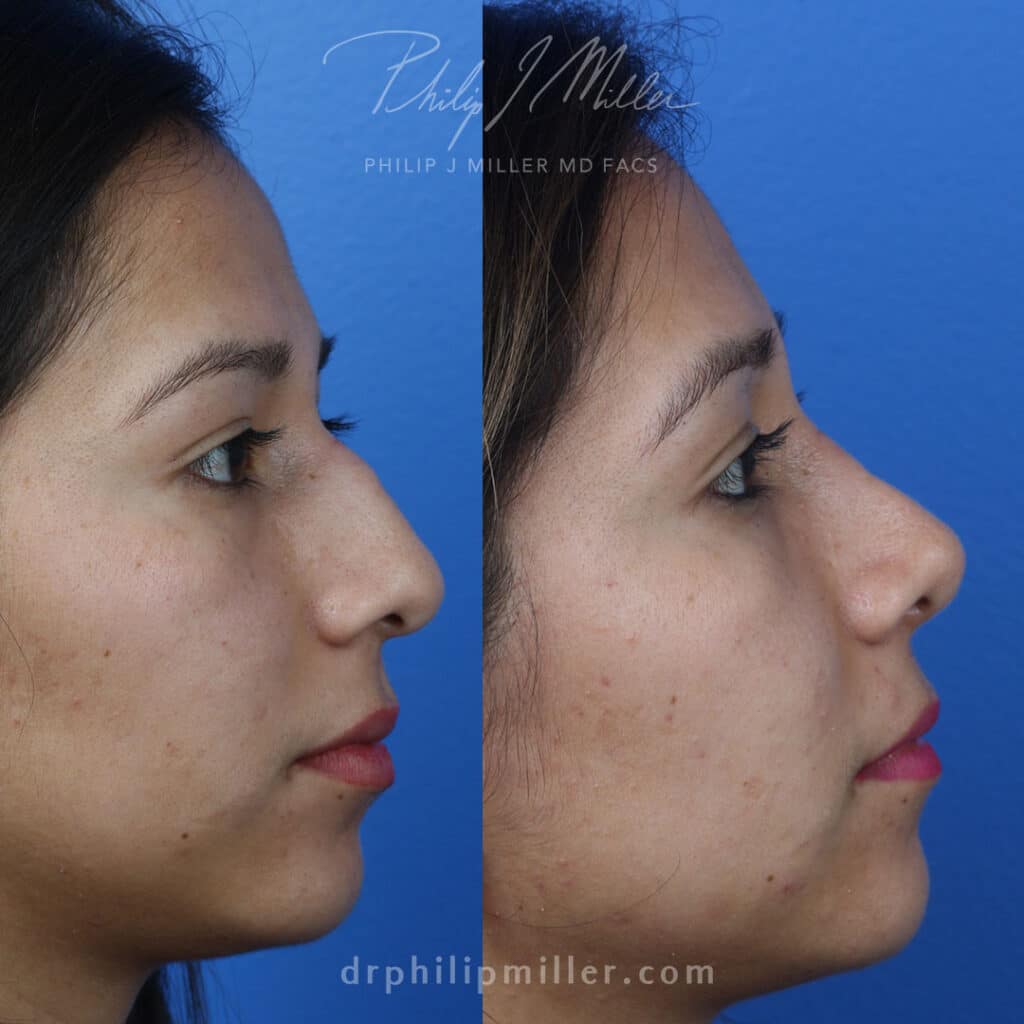
Bulbous Tip
A bulbous tip is wide and round and can also be called a ball tip nose. The bulb-like shape of the nasal tip is typically due to excess cartilage or cartilage without definition. A bulbous tip can also be due to thick nasal tip skin, which is often seen in ethnic noses. During nose tip surgery, the edges of the cartilage are trimmed to create a more refined nasal tip.
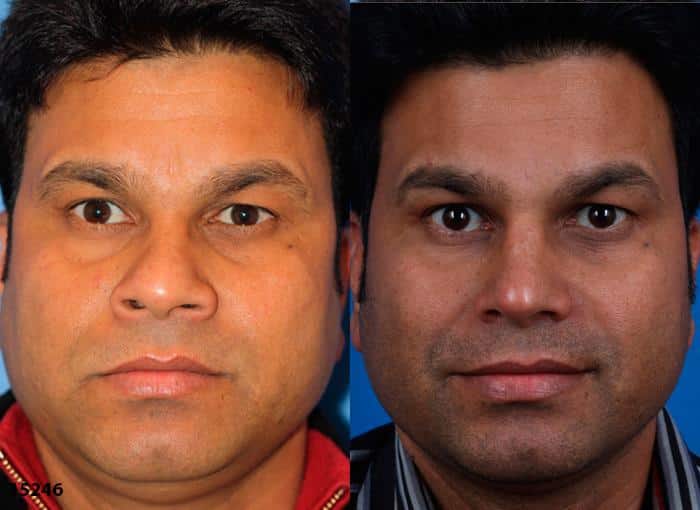
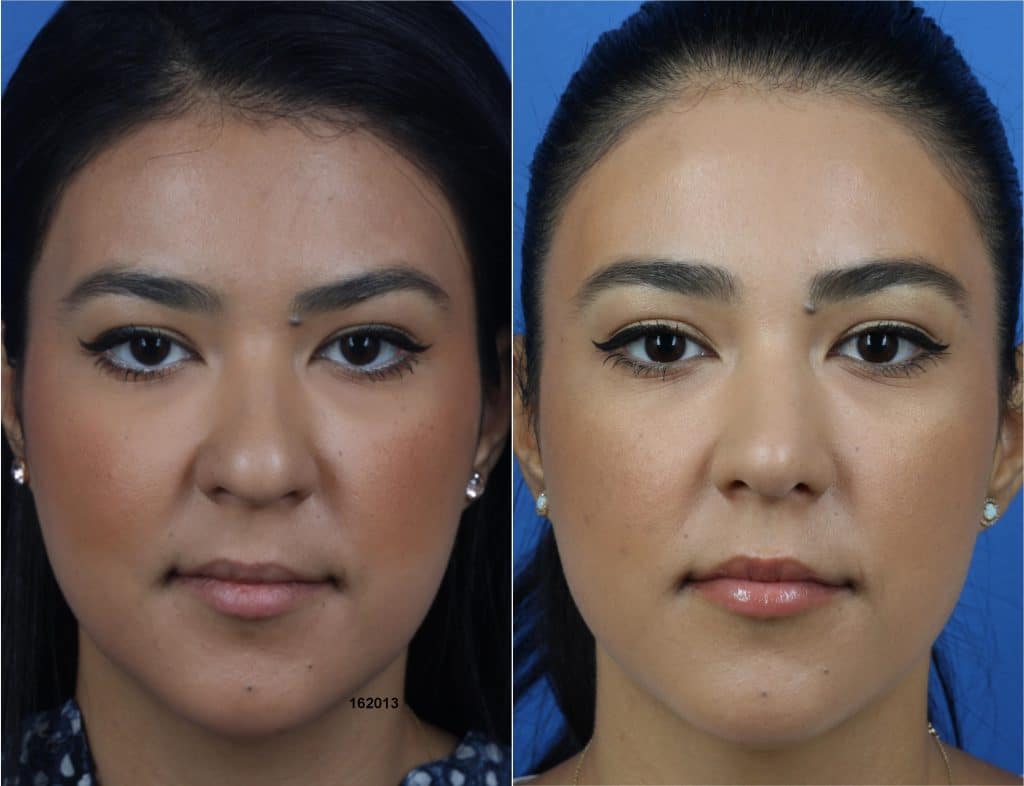
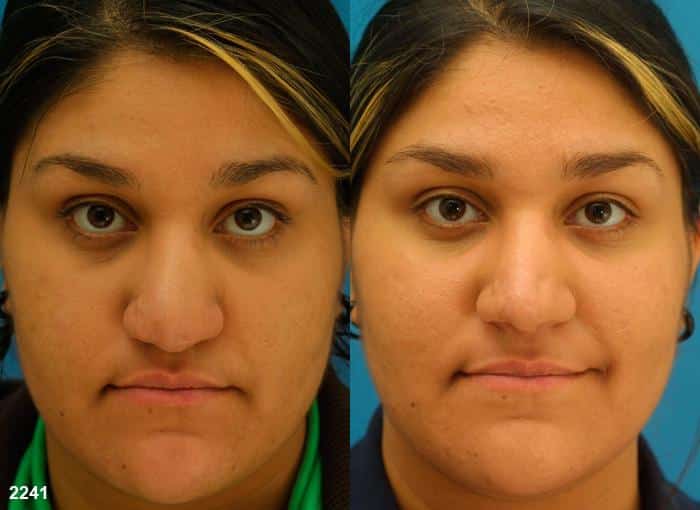
Drooping Nose Tip
A drooping nose tip is characterized by a downward slope that can sometimes result in an unnatural appearance, nasal blockage, and breathing issues. The drooping tip can form due to excess cartilage around the nose, aging, and skin laxity. Rhinoplasty is a permanent solution that can remove excess cartilage and provide support for the nasal tip, lifting and refining the nose for a more pleasing profile.
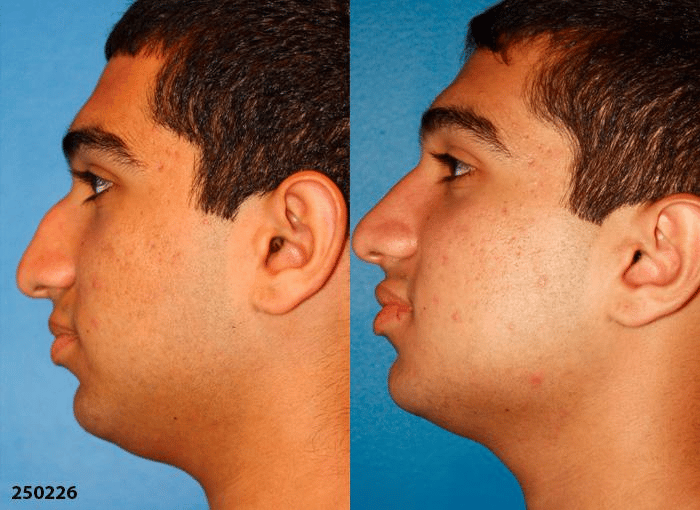
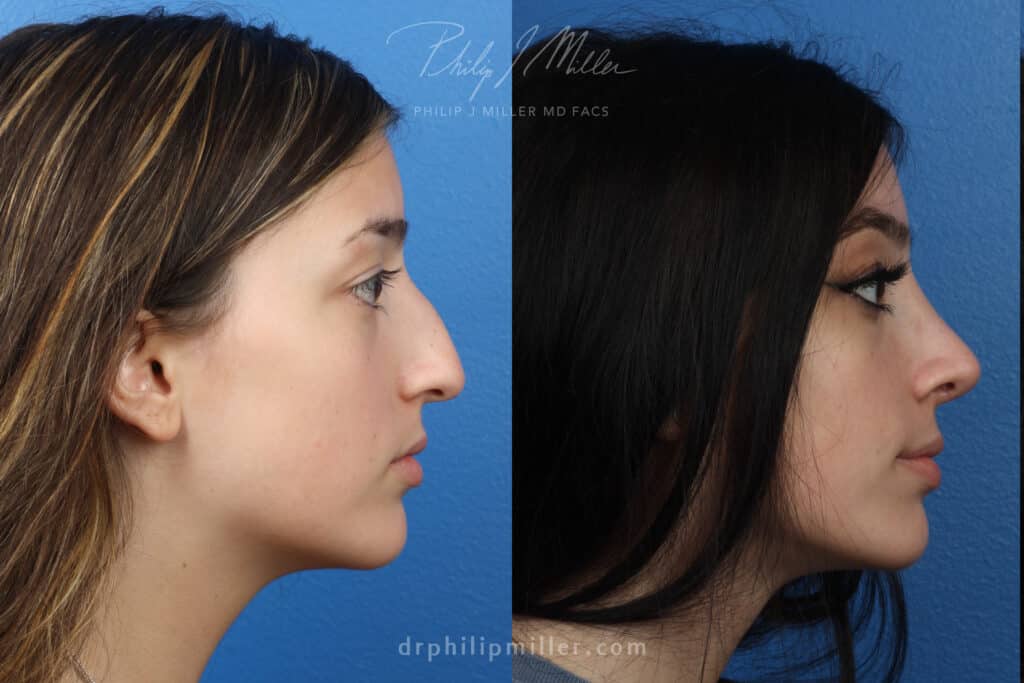
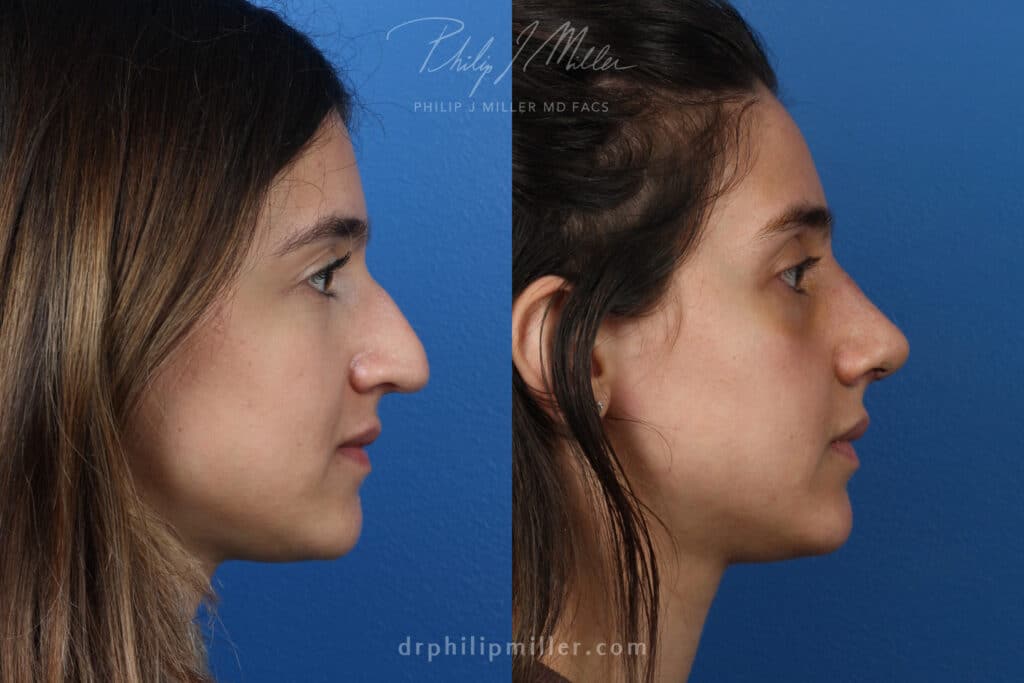
Droopy Nose when Smiling
Many patients have concerns about a droopy nose when they smile. A droopy nose when smiling can form from a weak structural base and droopy tip. The muscles around the nose move to make the tip appear droopy with wide nostrils making the problems more exaggerated during the facial expression. An expert surgeon can correct this concern and in some cases, temporary non-surgical treatments like Botox injections can also improve the droopiness.
Wide Nasal Base
A wide nasal base features a broad spread at the base of the nose, which can include enlarged nostrils that are disproportionate to the rest of the nose. In this case, a nose reduction procedure known as alar reduction can focus on narrowing the base of the nose by making the nostrils smaller, removing excess cartilage, and refining the nasal tip. Some ethnicities naturally have a wider nasal base that can be corrected by a facial plastic surgeon with expertise in ethnic rhinoplasty techniques.
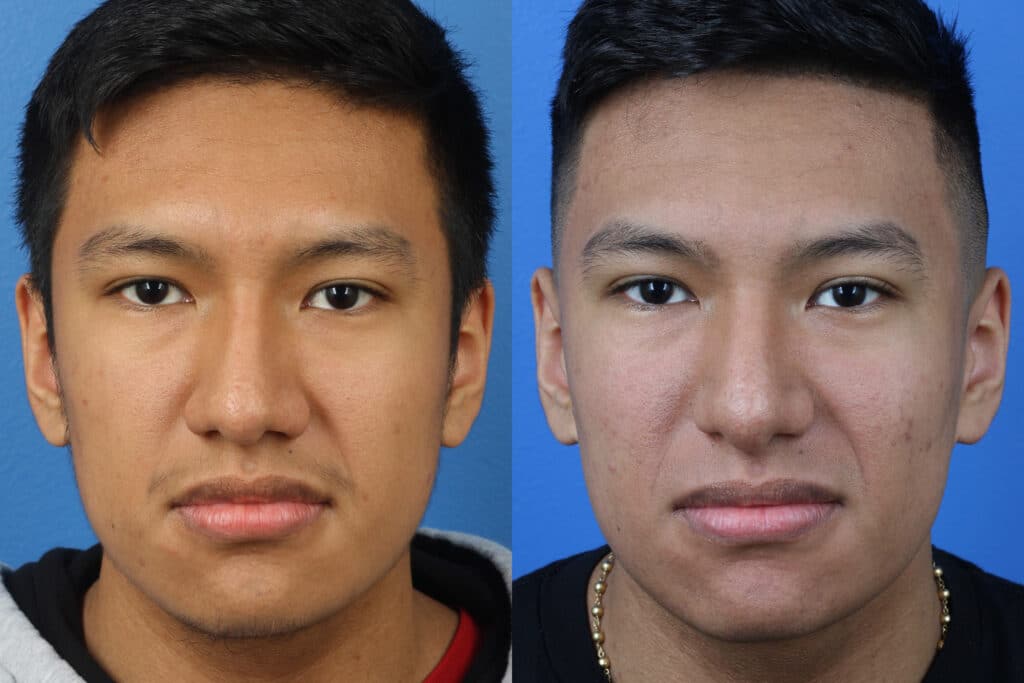
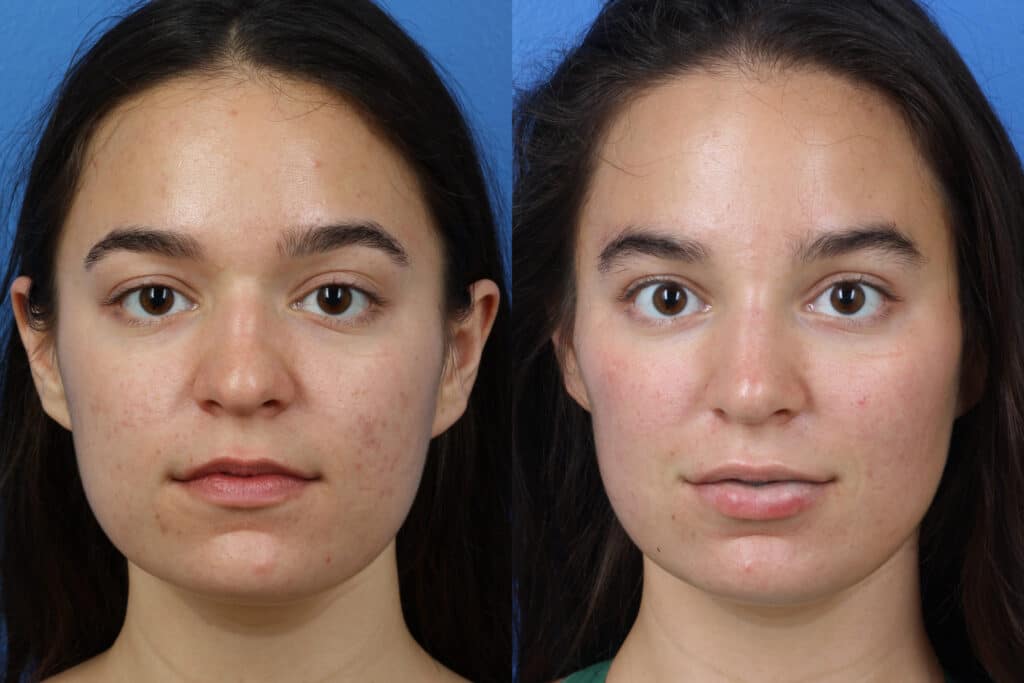
Hanging Columella
The columella is the tissue that separates the nostrils at the base of the nose. A hanging columella occurs when the connective structure drops lower than the base of the nose so it can be seen in the profile. Some patients are born with this feature, while others can have a long septum that pushes the columella downward. A hanging columella can be corrected with a rhinoplasty procedure and can be altered without reshaping any other portion of the nose.
Learn more about rhinoplasty here.
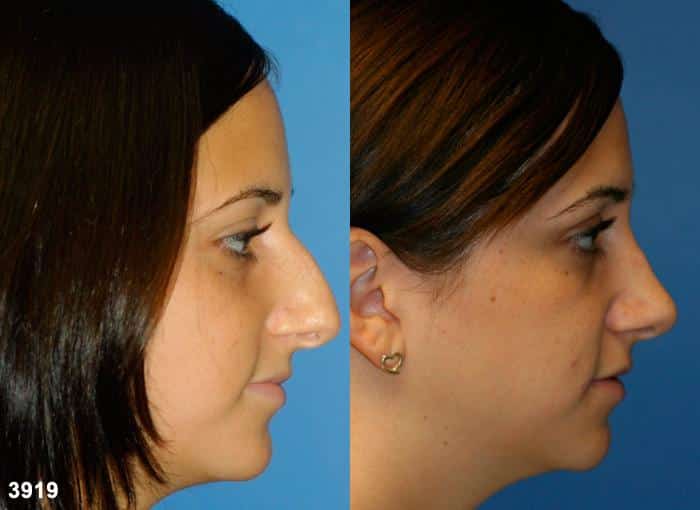
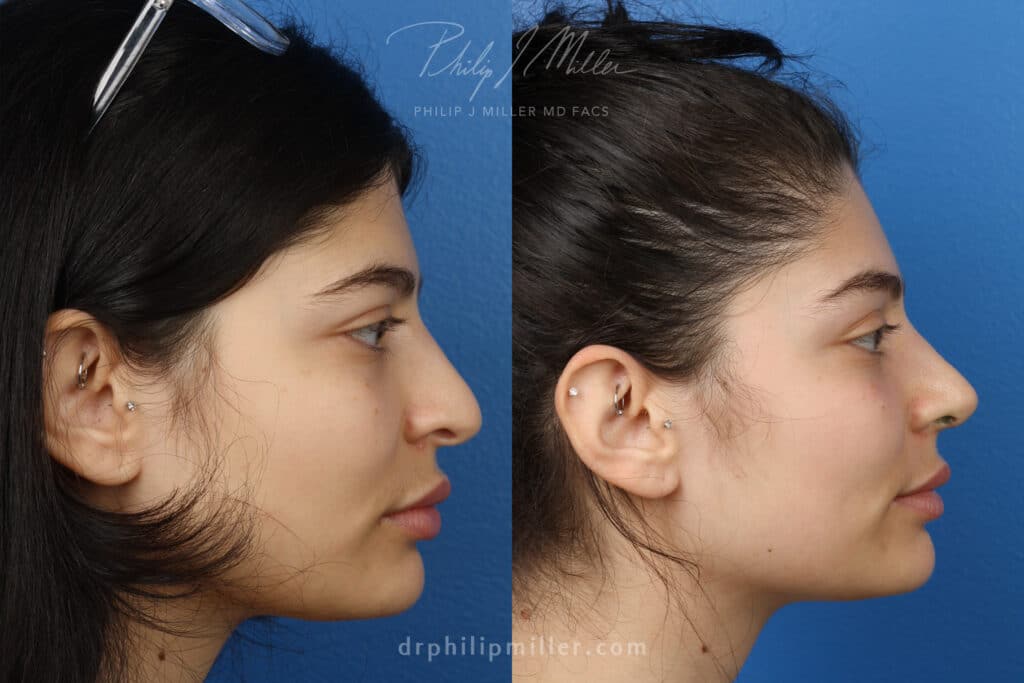
Concerns with Your Nose? Dr. Miller can Help
Dr. Philip Miller is a double board-certified facial plastic surgeon with more than two decades of experience in facial procedures including rhinoplasty. He provides a supportive environment for patients to explore their aesthetic beauty with his proprietary Natralook® process. Contact us to schedule a consultation and learn more about how rhinoplasty can change your appearance for the better.
5 Rhinoplasty Trends in 2022
Rhinoplasty surgery was the most frequently requested cosmetic surgery in 2020, with over 352,000 procedures performed.
Facial plastic surgeon, Dr. Philip Miller in New York City—one of the country’s leading experts in rhinoplasty and facial rejuvenation—can help you achieve a nose you’ll love. You may choose traditional rhinoplasty to reduce or reshape the nose. For other patients, non-surgical rhinoplasty is the right choice to achieve their aesthetic goals.
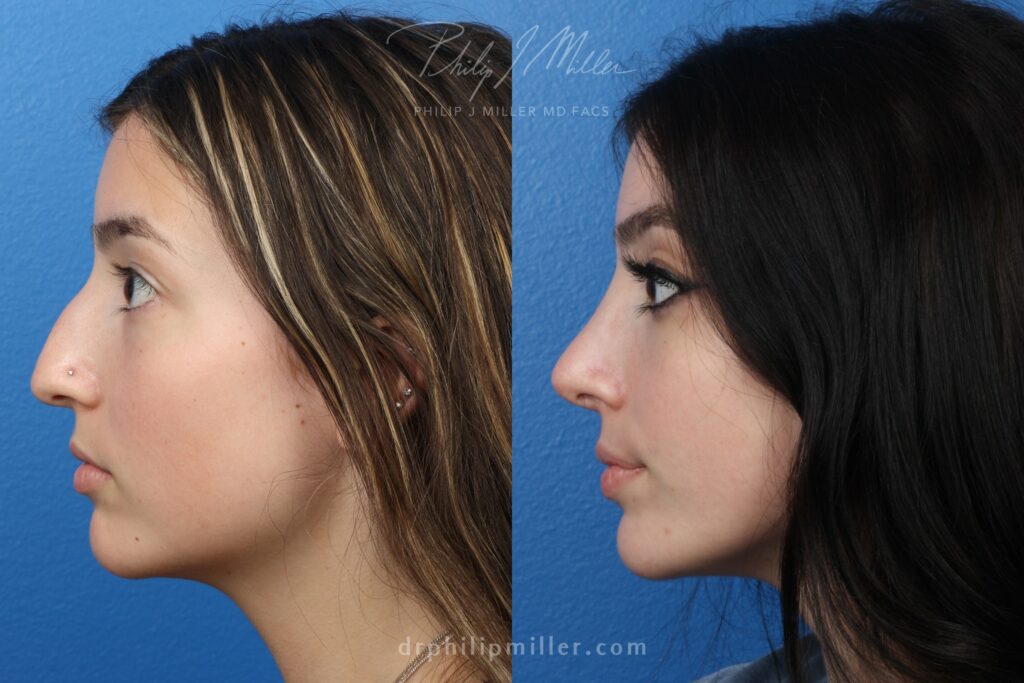
1. Zoom Boom Brings Rhinoplasty Boom
Because of the COVID-19 pandemic, 2020 was a challenging year for many businesses. But for Zoom, the video-conferencing giant, lockdown and working from home brought unprecedented growth.
Zoom usage jumped 67% between January 2020 and mid-March, when non-essential businesses and schools closed. The Zoom Boom also resulted in significant growth to an entirely different industry—cosmetic surgery.
The built-in cameras on our computers are clearly not designed to flatter the human face, and many people weren’t pleased with the reflection they saw on their computer screens.
The unflattering camera angle highlights facial flaws, such as wrinkling and sagging. People noticed unfamiliar lines, creases, and asymmetries as they saw themselves speaking on camera.
It’s not surprising that the Zoom phenomenon caused a booming demand for cosmetic procedures such as dermal injectables, laser treatments, and eye lifts.
On a Zoom conference call, the position of the computer’s camera relative to the user puts the focus on the center of the face, making the nose appear larger. As a result, demand for rhinoplasty significantly increased as well, and will likely continue into the New Year.
2. The Need for Natural
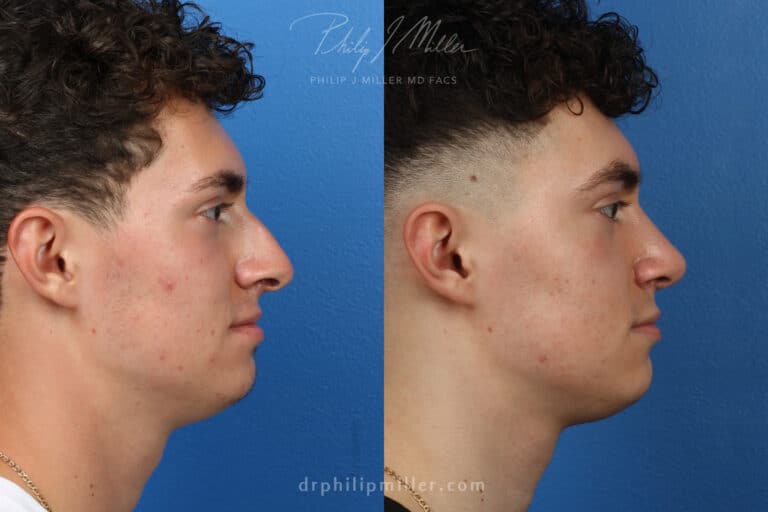
In Manhattan, Dr. Miller is renowned for the natural results he achieves for his patients, both with traditional rhinoplasty—for patients desiring more significant changes and permanent results—as well as non-surgical rhinoplasty, for patients seeking relatively minor corrections. As demands for natural results will continue to be a factor in 2022, Dr. Miller is prepared to deliver satisfying results to his New York patients.
Rhinoplasty, also known as a nose job, is a surgical procedure that can improve the appearance of the nose by reshaping, reducing, augmenting the tissue, removing a bump, or adjusting the angle between the nose and the mouth.
A major benefit of rhinoplasty is that it’s typically a “one-and-done” procedure. Once the surgery is complete and the nose has fully healed, patients can enjoy the improvements over their lifetime.
If you’re dissatisfied with your nose because of minor depressions or hollows that affect its overall appearance, non-surgical rhinoplasty may be the right solution for you. Non-surgical nose jobs are safe and effective, providing immediate results with exceptionally short recovery time. With this non-invasive procedure, injectable fillers are used to make small yet dramatic modifications to the nose.
Non-surgical rhinoplasty has its limitations, however. Since corrections are made with dermal fillers that ultimately dissolve, results aren’t permanent. Non-surgical nose jobs aren’t appropriate for every nose and can’t reduce the size of the nose.
Results will vary by patient, but the longevity of a non-surgical nose job is typically between 8-24 months. During your consultation, Dr. Miller will determine which fillers might help you achieve the best results and how long the improvement might last.
3. Faster Recovery Times
Plastic surgeons today are starting to use techniques to minimize post-procedure discomfort and healing time. Rhinoplasty is typically performed as an outpatient procedure under general anesthesia, and patients return home on the same day. While you may be up and moving within 24 hours, expect to take up to a week off from work or school as you heal.
For the first several days, you’ll need to keep your head elevated and apply ice packs to reduce swelling. Most swelling and bruising subsides within a week following rhinoplasty. Nasal dressings, splints, and sutures are removed at about seven days after surgery. At this point, any residual bruising can be effectively camouflaged with makeup. Most patients feel comfortable appearing in public at about 7-10 days post-surgery.
Swelling will continue to subside and the nose may continue to improve in definition for up to a year after surgery. However, beyond the first week, these changes are subtle and typically not noticed by others. Many patients are pleasantly surprised at how quickly they recover from rhinoplasty.
4. The Combination Approach
Achieving facial balance sometimes means making adjustments to the chin at the same time as the nose. Dr. Miller’s expertise with both procedures produces superior results.
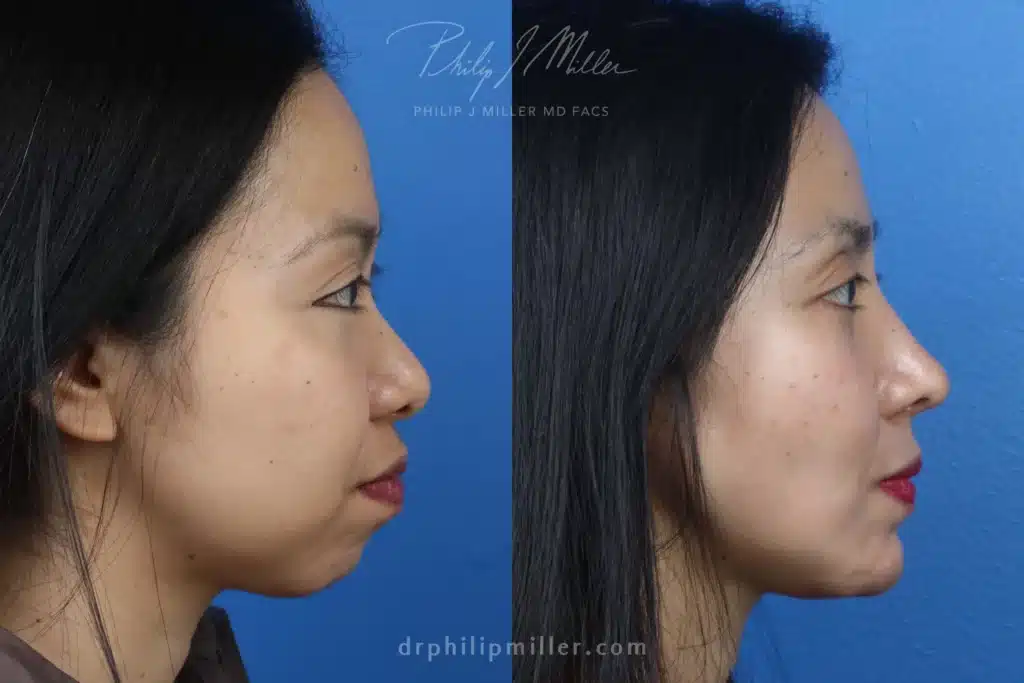 When rhinoplasty surgery is performed to improve the overall shape and appearance of a nose, a receding chin could diminish the aesthetic effect of the face, making it look unbalanced.
When rhinoplasty surgery is performed to improve the overall shape and appearance of a nose, a receding chin could diminish the aesthetic effect of the face, making it look unbalanced.
To achieve the best possible results with rhinoplasty, the proportions of the entire face must be considered. If your chin is well defined and proportionate to your new nose, your overall appearance will be aesthetically enhanced by rhinoplasty alone.
If you have a receding chin, however, chin augmentation surgery performed along with rhinoplasty surgery can give your face balance that rhinoplasty alone could not have achieved. Therefore, many board-certified plastic surgeons are beginning to suggest chin augmentation with rhinoplasty for certain patients.
Recovery after a chin implant takes around two weeks. You may experience swelling, tenderness, and bruising in the chin area immediately after the procedure, but most of these symptoms will diminish within about a week. Eating soft foods during the first week after surgery will help to make your recovery period more comfortable.
5. Image Morphing
The ability to “see” your results before surgery is a benefit that more patients are wanting from their rhinoplasty surgeon. At his Manhattan office, Dr. Miller uses computer imaging to help patients visualize their new nose before undergoing surgery. Besides helping communicate the goals of the patient to the surgeon before the procedure, image morphing also helps ensure patient expectations are in line with results.
If you have difficulty visualizing what your ‘after’ may look like, image morphing can help. While the final result may not be absolutely identical to the morphed picture, it provides a good idea of what you can expect.
The NatraLook Process
Aesthetic Confidence is the sense of empowerment we feel about the way we look, dress, design, and decorate. It dovetails with confidence in our abilities, intellect, and emotions. The NatraLook Process focuses exclusively on the look component of Aesthetic Confidence. The NatraLook Process is an enriching experience through which you explore and ultimately boost your aesthetic confidence by enhancing your appearance.
The NatraLook process evaluates and expands the typical plastic surgery experience into a safe, non-intimidating opportunity to explore your aesthetic confidence. It creates a unified vision of your desired result so that you and New York surgeon Dr. Philip Miller know what to expect.
Contact an Expert Plastic Surgeon to Learn More About Rhinoplasty in New York City
Whichever procedure you ultimately choose, Dr. Miller can help you achieve your goals. His approach combines art and science with skill and innovation, providing patients in Manhattan, New York, aesthetically pleasing, natural results that are always in style.
To learn more about rhinoplasty surgery and non-surgical nose jobs, contact us online or call our practice in New York. One of our patient advisers will be happy to help you.